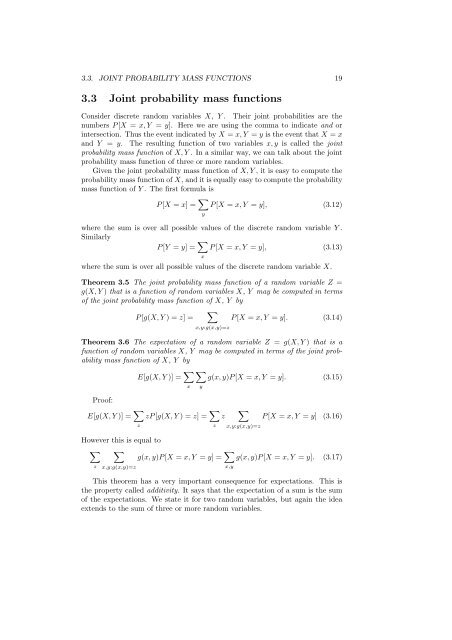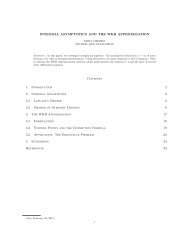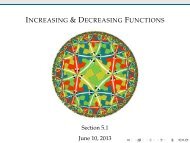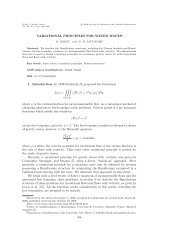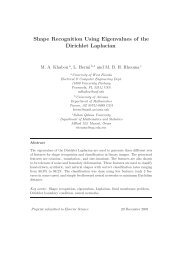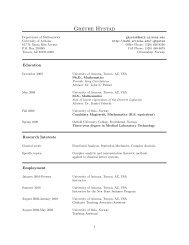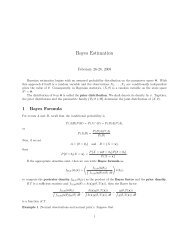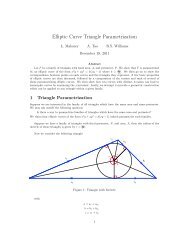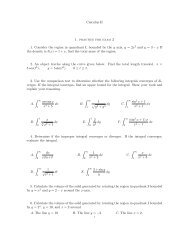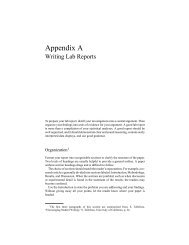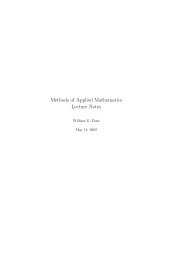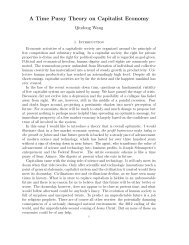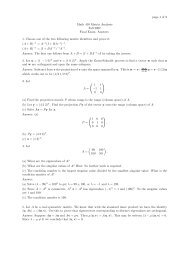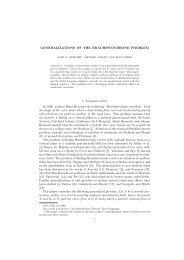Lectures on Elementary Probability
Lectures on Elementary Probability
Lectures on Elementary Probability
Create successful ePaper yourself
Turn your PDF publications into a flip-book with our unique Google optimized e-Paper software.
3.3. JOINT PROBABILITY MASS FUNCTIONS 19<br />
3.3 Joint probability mass functi<strong>on</strong>s<br />
C<strong>on</strong>sider discrete random variables X, Y . Their joint probabilities are the<br />
numbers P [X = x, Y = y]. Here we are using the comma to indicate and or<br />
intersecti<strong>on</strong>. Thus the event indicated by X = x, Y = y is the event that X = x<br />
and Y = y. The resulting functi<strong>on</strong> of two variables x, y is called the joint<br />
probability mass functi<strong>on</strong> of X, Y . In a similar way, we can talk about the joint<br />
probability mass functi<strong>on</strong> of three or more random variables.<br />
Given the joint probability mass functi<strong>on</strong> of X, Y , it is easy to compute the<br />
probability mass functi<strong>on</strong> of X, and it is equally easy to compute the probability<br />
mass functi<strong>on</strong> of Y . The first formula is<br />
P [X = x] = ∑ y<br />
P [X = x, Y = y], (3.12)<br />
where the sum is over all possible values of the discrete random variable Y .<br />
Similarly<br />
P [Y = y] = ∑ P [X = x, Y = y], (3.13)<br />
x<br />
where the sum is over all possible values of the discrete random variable X.<br />
Theorem 3.5 The joint probability mass functi<strong>on</strong> of a random variable Z =<br />
g(X, Y ) that is a functi<strong>on</strong> of random variables X, Y may be computed in terms<br />
of the joint probability mass functi<strong>on</strong> of X, Y by<br />
∑<br />
P [g(X, Y ) = z] = P [X = x, Y = y]. (3.14)<br />
x,y:g(x,y)=z<br />
Theorem 3.6 The expectati<strong>on</strong> of a random variable Z = g(X, Y ) that is a<br />
functi<strong>on</strong> of random variables X, Y may be computed in terms of the joint probability<br />
mass functi<strong>on</strong> of X, Y by<br />
E[g(X, Y )] = ∑ ∑<br />
g(x, y)P [X = x, Y = y]. (3.15)<br />
x y<br />
Proof:<br />
E[g(X, Y )] = ∑ z<br />
zP [g(X, Y ) = z] = ∑ z<br />
∑<br />
z P [X = x, Y = y] (3.16)<br />
x,y:g(x,y)=z<br />
However this is equal to<br />
∑ ∑<br />
z<br />
x,y:g(x,y)=z<br />
g(x, y)P [X = x, Y = y] = ∑ x,y<br />
g(x, y)P [X = x, Y = y]. (3.17)<br />
This theorem has a very important c<strong>on</strong>sequence for expectati<strong>on</strong>s. This is<br />
the property called additivity. It says that the expectati<strong>on</strong> of a sum is the sum<br />
of the expectati<strong>on</strong>s. We state it for two random variables, but again the idea<br />
extends to the sum of three or more random variables.


